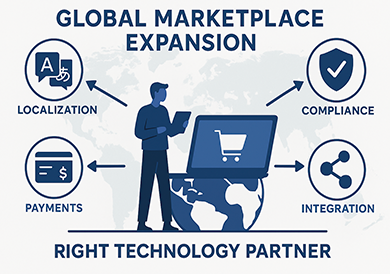.png)
The energy industry is in the midst of a radical transformation. From utilities and oil & gas to renewable energy and smart grids, legacy infrastructures and manual processes can no longer keep pace with demands for decarbonisation, resilience, and consumer-centric services. As energy companies modernise (deploying IoT sensors, predictive analytics, automated trading, demand response systems, and more) their software and engineering needs multiply. Yet, one obstacle looms large: the shortage of domain-aware tech talent capable of executing on these advanced digital initiatives.
That’s where tech staff augmentation for the energy sector becomes a strategic lever. Rather than enduring long hiring cycles or overbuilding internal teams, energy firms can plug in external, pre-vetted engineers into their existing structures. The result: faster project delivery, lower risk, and access to specialised skills on demand.
In this article, we’ll explore why staff augmentation is uniquely suited for energy, dissect common use cases (smart grids, AI forecasting, integration, compliance), and show how Patternica, as an outsourcing and augmentation partner, can make the difference for energy organisations ready to scale.
Why the energy industry struggles with in-house tech scaling
→ Global tech talent shortage in energy
The demand for software engineers, data scientists, IoT specialists, and AI/ML experts is high across industries - but energy presents extra challenges. Many developers lack domain familiarity (e.g. power systems, grid operations, SCADA, regulatory constraints). In many regions, the pool of engineers blending energy and software knowledge is extremely thin. Meanwhile, green jobs are expanding rapidly: in Germany, for instance, roles tied to the energy transition more than doubled between 2019 and 2024, and employers now struggle to fill half of them.
Recruitment cycles in energy firms are slow, and offering competitive salaries for niche talent is difficult, especially in smaller markets. The result: internal teams are overworked, projects stall, and innovation lags.
→ Legacy infrastructure and integration complexity
Many energy companies still operate legacy systems: SCADA, supervisory control, proprietary hardware, unconnected field devices, and siloed data platforms. Introducing new software (for predictive maintenance, energy forecasting, distributed resources) requires deep systems-level integration. That means bridging OT/IT layers, building APIs, handling real-time data streams, and ensuring low latency.
If an internal team lacks experience in integration, middleware, or field communications protocols (Modbus, DNP3, IEC 61850, MQTT, etc.), adoption stalls and systems fragment.
→ Compliance, security, and regulatory challenges
Energy systems are critical national infrastructure. They must adhere to compliance standards (e.g., NERC CIP, ISO, GDPR, local grid codes). Cybersecurity is paramount - any breach or outage can have catastrophic consequences. Designing and deploying software under these constraints carries much more risk than in a typical web app.
Internal teams lacking compliance or cybersecurity expertise can inadvertently create vulnerabilities, incur fines, or trigger blackouts. Augmented engineers bring not only development skills but domain-aware security best practices.
Top 5 technical challenges in energy - and how augmentation helps
| Challenge | Impact | Typical cost / risk | Staff augmentation solution |
| Legacy SCADA and OT systems | Data silos, delayed decisions | Operational inefficiencies, downtime | Augment with integration/API engineers |
| Limited tech talent | Slow projects, overloaded staff | Increased overtime, burnout | On-demand engineers to relieve bandwidth |
| Compliance & cybersecurity risk | Fines, outages, reputational damage | Regulatory penalties | Certified security/compliance engineers |
| Complexity of integrating renewables & DERs | Inability to scale | Loss of flexibility, poor scaling | Devs experienced in distributed energy systems |
| Slow innovation | Missed market windows | Competitive disadvantage | Agile, flexible engineering capacity |
By tapping into an augmented workforce, energy organisations can relieve bottlenecks, accelerate modernisation, and avoid the pitfalls of hiring and training full-time teams from scratch.
Let’s build the energy systems of tomorrow
Contact UsWhat is tech staff augmentation (and why it works for energy companies)
Staff augmentation is a model where external technical resources (engineers, developers, data scientists) are added to an existing internal team to expand capacity or fill specialised gaps. The augmented resources work under your management and integrate into your processes, rather than being a black-box vendor.
Essentially, it allows organisations to flexibly scale the team up or down, while retaining control over project direction, architecture, and quality.
| Feature | Staff augmentation | Traditional outsourcing |
| Management & control | Client retains full control | Vendor has ownership |
| Flexibility | Able to scale team size dynamically | Fixed scope, harder to change |
| Integration | Work inside your workflows | Separate delivery pipeline |
| Accountability | Augmented staff report to your leads | Vendor accountable to contract |
| Cost structure | Pay for actual hours/roles | Often fixed or milestone-based fees |
For energy firms, where domain alignment and continuous iteration matter, the control and tight alignment of augmentation often outweigh the appeal of fully outsourced models.
Why it’s a fit for energy companies
Variable project load
Energy initiatives (e.g. smart meters rollout, grid modernisation, AI forecasting) are often cyclical or unpredictable. Augmentation allows scaling just when needed.
Domain overlap
You often need engineers who understand both energy and software - not generic devs. Augmentation providers can pre-match domain-aware talent.
Risk mitigation
You don’t commit to full-time hires that may later be idle or misaligned.
Faster ramp-up
You can onboard external engineers quickly vs. lengthy recruitment.
Key use cases of staff augmentation in the energy sector
● Smart grid software development
Energy providers are deploying smart grids to optimise load, reduce losses, and integrate distributed energy resources (DERs). That requires embedded software, real-time control, IoT connectivity, and predictive algorithms.
Augmented teams can handle:
✓ Sensor data ingestion, edge computing, and streaming platforms
✓ Automated grid balancing and demand response logic
✓ Integration with OMS/EMS systems
✓ Firmware, communication stacks, and protocol handling
● Energy data analytics & visualisation
Data is power in energy - consumption patterns, forecasts, price signals, emissions, and fault detection all rely on analytics and dashboards. But many energy firms lack the in-house data science capacity.
Augmented roles include:
✓ Data engineers to build pipelines and ETL frameworks
✓ ML/AI engineers to build demand forecasting, anomaly detection, or asset health models
✓ Front-end and UX developers to deliver interactive dashboards
✓ Business analysts with domain knowledge to translate KPIs
● Renewable energy & DER management platforms
As solar, wind, battery storage, and microgrids proliferate, energy firms build platforms to manage and dispatch these assets. That means integrating APIs across devices, tracking status, and automating control.
Augmentation possibilities:
✓ API engineers who tie assets to central control systems
✓ Cloud engineers for scalable back-end services
✓ DevOps and infrastructure experts for deployment and resiliency
✓ QA engineers to test across multiple device configurations
● Cybersecurity, compliance & automation
Given the critical nature of energy infrastructure, robust security is non-negotiable.
Augmented engineers can assist:
✓ Security architecture, threat modeling, and penetration testing
✓ Automation of compliance workflows and audit reporting
✓ DevSecOps practices embedded in CI/CD
✓ Real-time anomaly detection and intrusion detection systems
Let’s build the energy systems of tomorrow
Contact UsHow tech staff augmentation accelerates innovation in energy
Faster project delivery
With augmented engineers joining your team, you can parallelise work streams, accelerate sprints, and hit milestones faster. No more waiting months for new hires to ramp - you get seasoned devs ready to contribute from day one.
Cost efficiency & predictable budgets
Recruiting, onboarding, benefits, training, and attrition all add hidden costs. Staff augmentation moves much of that burden to the augmentation provider. You get transparency: pay for productive dev hours rather than absorbing fixed salaries.
Access to specialised expertise
Energy software frequently demands niche skills: power systems simulation, SCADA protocols, DER orchestration, grid modeling, or compliance. Augmentation providers can maintain a talent pool with exactly the deep domain experience you need.
Scalability & business continuity
When your energy project pipeline expands (or dips), you can flex your team size accordingly. You avoid staffing cliffs, maintain continuity, and ensure your internal core remains lean and focused.
How Patternica helps energy companies scale with tech staff augmentation
Patternica uses a rigorous screening process to recruit engineers with both software mastery and energy/industrial experience. Once identified, these engineers are ready to integrate with your team. We aim for rapid onboarding (often within 48 hours) so your projects don’t stall.
We align with your time zone, processes, communication rhythms, and tech stack to make augmented engineers feel like internal members from day one.
| Service | What we do | How you benefit |
| API & system integration | Bridge SCADA, ERP, MES, CRM, IoT | Unified data pipelines, seamless interoperability |
| IoT & embedded development | Edge computing, device firmware, communication | Real-time control and sensor networks |
| AI/ML analytics | Demand forecasting, anomaly detection, asset health | Smarter operations, lower downtime |
| UI/UX for energy apps | Dashboards and monitoring tools | Better visibility for operators and analysts |
| Cloud & backend architecture | Scalable microservices, serverless, containerisation | Cost-effective, resilient infrastructure |
Patternica helps energy companies accelerate their digital transformation while mitigating hiring risk and ensuring domain-aligned execution.
Let’s build the energy systems of tomorrow
Contact UsConclusion
The energy sector is facing urgent pressures: decarbonisation, grid modernisation, consumer expectations, distributed energy, and resilience demands. To meet this moment, companies need not only the capital and vision - they also need flexible, expert tech talent that can bridge the gap between energy domain complexity and digital innovation.
Tech staff augmentation is a powerful enabler: it lets energy firms scale intelligently, deliver faster, manage risk, and gain access to rare domain skills without bloating internal teams. When carried out thoughtfully, it becomes a strategic lever rather than a stopgap.
Patternica is your partner in this transformation. With deep expertise in energy software, rigorous talent matching, and flexible engagement models, we embed seamlessly into your teams and help you accelerate your roadmap - without compromising control, security, or quality.
FAQ
What is tech staff augmentation for the energy industry?
It’s a model where external engineers (with domain and software skills) are added to your internal team, allowing you to scale capacity without hiring full-time employees.
How is it different from outsourcing?
You maintain project control, governance, and process alignment. Augmented engineers act as part of your team rather than an external vendor executing separately.
What types of energy projects can be supported?
Smart grid development, IoT device workloads, AI analytics, renewable integration platforms, compliance tooling, cybersecurity, and more.
How fast can Patternica deliver augmented engineers?
Often within 48 hours - we pre-match your needed skills and time-zone fit so onboarding is swift.
Is it cost-effective?
Yes, you pay for active engineering time, avoid sunk HR and recruiting costs, and scale without committing to long-term overheads.


.png)